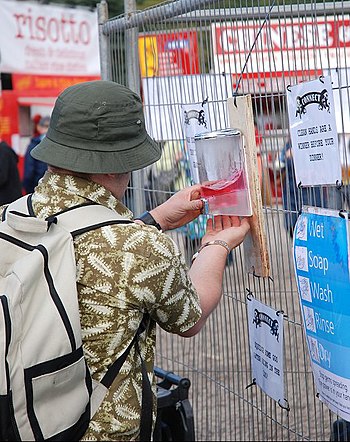 |
| English: Hand hygiene at Connect 2007 Thoughtful provision of hand sanitiser at the 2007 Connect festival enabled people to clean their hands before buying and eating food. (Photo credit: Wikipedia) |
Not just hygiene, mindsets need an overhaul, too
Liang Dingzi
IN LIGHT of the recent Geylang Serai food poisoning tragedy which has claimed two lives and made more than 150 people ill, I recalled how my colleagues used to joke about favouring one stall over another selling the same fare even though it received a lower grading from the National Environment Agency (NEA).
Somehow, the general consensus was that the food tasted better, and the attitude one of bold defiance against good sense. It is as if food being clean and being tasty are mutually exclusive. Therefore, few people really pay heed to the NEA grading — and hawkers know it.
As Health Minister Khaw Boon Wan noted, labelling would work only if consumers were guided by the hygiene ratings. While he urged stallholders to improve their hygiene levels, customers could play their part by not patronising dirty stalls.
It is regrettable that it has to take a tragedy to drive home a lesson as important as this. But it is never too late to learn. Even more disturbing is Mr Khaw’s rating of Singapore as being close to a “fail” grade on matters of hygiene, compared with the 2003 Sars outbreak. It shows how quickly lessons are forgotten.
Blame it on complacency. Our attitude must change. Errant operators must be made to pay the price, whether through hefty fines, suspension of licences or public shaming, or a combination of measures.
However, too often, ignorance may be the culprit. And all parties — regulator, operators and customers — have a role to play in raising service and hygiene standards in hawker centres here.
To assist the operators and their helpers, the NEA can ensure they are adequately trained in safe food handling practices by arranging the appropriate courses. We have successfully instituted customer service training to raise the service level even at hawker centres as part of the campaign to improve Singapore’s global hospitality rating. Similarly, we can do as well to improve food handling hygiene, especially when the Singapore Tourist Board is marketing Singapore as a gourmet paradise.
Operators and their helpers can present a more professional image. There is no excuse for table cleaners to look unkempt. Some hawker centres have introduced uniforms to enhance their image.
A common sight is uncovered or exposed overflowing garbage bins that invite flies and other insects, as well as birds and rats. This cannot be permitted.
Most stalls do not have the luxury of space. The design could be improved to allow for more storage and work space so that there is clearer segregation between raw materials and cooked food.
While the NEA has done a good job in upgrading many food centres, the basic design of some of them has public toilets — another area of concern mentioned by Mr Khaw — located too near the stalls. They should be tucked away and operators must not use them as a matter of expedience to wash their dishes.
Customers must respect the work the cleaners and operators do. They can also help by not messing up the tables where they eat. By removing used plates, bowls and cutlery to their respective receptacles for disposal, the flies and other scavengers are likely to stay away.
The writer is a management consultant and freelance contributor.
Email your views to voices@mediacorp.com.sg
From TODAY, Voices – Wednesday, 15-April-2009










No comments:
Post a Comment